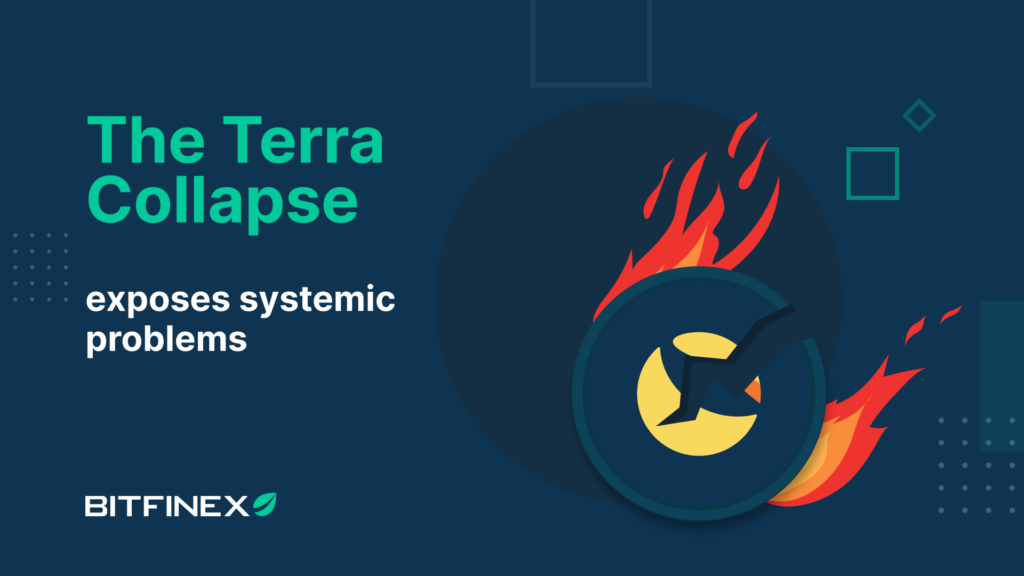2022 Year In Review – Part 2
The Bear Market Begins To Accelerate April On April 1, 2022, Bitcoin was hovering around $46,000, but a few days later, it resumed its bearish momentum, and began to decrease in price. STEPN, the “move 2 earn” NFT game was in the headlines, three Chinese... The post 2022 Year In Review – Part 2 appeared first on Bitfinex blog.

The Bear Market Begins To Accelerate
April
On April 1, 2022, Bitcoin was hovering around $46,000, but a few days later, it resumed its bearish momentum, and began to decrease in price. STEPN, the “move 2 earn” NFT game was in the headlines, three Chinese Financial Associations moved against NFT trading, as the Ronin Bridge hacker kicked off a series of events which may have led to the eventual sanctions on Tornado Cash, Ethereum’s coinjoin platform for user privacy.
As Bitcoin began to fall in price around the end of the first week of April, DeFi was hit especially hard and ended the month at -47 percent, shedding almost $50 billion from its all time high total market cap, while Bitcoin and Ethereum ended the month at -18 percent and -24 percent respectively. Peripheral altcoin tokens fared worse due to their increased volatility and speculatory nature.
The Ronin hacker began sending over 21,000 stolen ETH to be mixed via Tornado Cash to obfuscate ownership, and throw investigators off their trail. The Ronin bridge hack was the most recent in a series of hacks in which cybercriminals such as the famed North Korean hacker group Lazarus, utilised Tornado Cash to muddy the waters and make their ill gotten gains harder to trace.
Terra continued to perform well, adding two percent in locked value to have 16 percent in total value locked, which ranked it as the second biggest blockchain platform after Ethereum, for locked value within smart contracts. This growth for Terra came at a time when other blockchain platforms collectively lost 9.6 percent in value locked, month over month, with Fantom becoming the biggest loser in locked value, as it finished the month at -32.6 percent in value held within its smart contracts.
May
Terra’s Luna token started the month of May at a price of $82.24, and on May 4th, reached a price of $86.16 before beginning its epic implosion as Luna began to plummet and lose 94 percent of its value over the next several days, reaching a price of less than $0.02 per token, bankrupting thousands of token holders.
Luna’s price decline was caused due to Terra’s UST stablecoin losing its peg with the US Dollar. Luna was a token which was supposed to algorithmically regulate volatility with UST, by programmatically minting and burning Luna tokens. Terra had previously announced a $3.5 billion Bitcoin reserve fund which inspired a high degree of investor confidence and was liquidated in an effort to maintain the peg.
As UST plummeted, it brought Luna down with it, as both tokens entered a death spiral. Terra futures saw liquidations of over $106 million USD. U.S. Treasury Secretary Janet Yellen even went so far as to address the issue at a Senate Banking Committee hearing. The Terra debacle would prove to send shockwaves throughout the industry.
While Terra’s downfall dominated the headlines, Instagram announced its plans for implementing NFTs, and Argentina began to investigate Bitcoin mining as energy costs soared. Argentina is a Bitcoin mining hub, which hosts over 20 large scale Bitcoin mining companies which operate locally.
The Terra Collapse Exposes Systemic Problems

June
The month of June started off lacklustre with Bitcoin trading around $31,800, and altcoins performing slightly worse. On June 13, 2022, industry leading crypto lending platform Celsius Network froze withdrawals and transfers, by involuntarily placing users on “HODL Mode” creating fears that it was insolvent.
This move by Celsius caused widespread panic and Bitcoin dropped to 18 month lows, to a price of $22,725. Ether also reached lows not seen since January 2021, falling 18 percent to $1,176. Celsius offered fiat loans collateralized by crypto, and also lent out cryptocurrency tokens at interest.
Celsius plummeted in value from $25 billion to eventually only having $167 million in cash on hand, it held $11.8 billion in assets, owed its users around $4.7 billion, and had an additional deficit in its balance sheet of around $1.2 billion. While it is true that Celsius did lose a significant amount of funds in the Terra collapse, its problems began much earlier.
On Monday June 27, 2022, Voyager publicly announced that Three Arrows Capital (3AC) had defaulted on a $665 million loan, and on Wednesday the same week, a court in the British Virgin Islands ordered 3AC into liquidation. 3AC had around $3 billion in Assets Under Management (AUM). 3AC also suffered losses in the Luna collapse. Curiously enough, Voyager also received $500 million in bailout funding from Sam Bankman Fried’s (SBF) Alameda capital, the week before the 3AC default announcement.
July
On July 1, 2022, a story broke in which 3AC filed for bankruptcy under chapter 15 of US bankruptcy laws, after Singapore’s Monetary Authority of Singapore (MAS) reprimanded the company for providing false information about its relocation to the British Virgin Islands in 2021. 3AC had also flagrantly exceeded its $250 million (Singapore Dollars) cap on AUM.
FTX also signed a deal in which it loaned $240 million to beleaguered crypto lending platform BlockFi, which gave it the option to purchase the lending company. BlockFi was exposed to 3AC, and also saw a massive increase in withdrawals due to Celsius’ freezing of user withdrawals, even though BlockFi itself was not affected by Celsius directly.
Voyager also filed for chapter 11 bankruptcy after freezing withdrawals, on July 6, 2022, facing losses stemming from the 3AC bankruptcy. Celsius, Babel Finance and Vauld alsol paused withdrawals in July, affected by the Terra collapse, exposure (in some cases) to 3AC, as well as the impact of monetary tightening from the Fed.
Elon Musk’s Tesla dumped 75 percent of its Bitcoin holdings, contradicting the eccentric billionaire’s earlier statement in March that he wouldn’t sell his Bitcoin:
“I might pump, but I don’t dump … I definitely do not believe in getting the price high and selling or anything like that. I would like to see Bitcoin succeed.”
Twitter also sued Elon Musk in July after he threatened to back out of his offer to purchase the social media platform because of the amount of bots on the platform.
August
In August, Babel Finance announced it had lost $280 million in customer funds due to making bad trades, and around the same time, Facebook parent Meta announced its loss of $2.8 billion on its Metaverse division in Q2. On August 29, 2022 Meta also announced that they would begin rolling out NFTs on Instagram.
Mike Novogratz’s Galaxy Digital posted a loss of $554 million in Q2, which was triple the amount he lost in Q2 of the previous year. Galaxy said the losses were unrealized and attributed mostly to positions in Luna & Ethereum.
Solana was hit by two major exploits within hours as Nomad Bridge was hacked for $152 million in what was dubbed a “Free For All” attack, and hours later another attacker was able to successfully drain almost 8,000 wallets for around $8 million in SOL and USDC SPL tokens.
Just days after the Solana attacks, the U.S. Treasury’s Office of Foreign Assets Control (OFAC) sanctioned Tornado Cash, an Ethereum-based coinjoin platform which allowed many users to mix their coins together in an effort to provide user privacy. OFAC alleged that Tornado Cash had laundered $455 million in stolen funds for the North Korean hacker group, Lazarus.
The Tornado Cash sanctions were a first, as a decentralised smart contract had never before been sanctioned, as code and software have been protected as free speech since the 90’s. Dutch authorities also arrested Tornado Cash developer Alexey Pertsev, another first, and he remains in custody, despite protests. Tornado Cash is a decentralised smart contract and protocol, so it remains in operation despite the sanctions.
In more positive news, Holepunch launched Keet, a Peer to Peer (P2P) video chat and messaging app without middlemen, third-parties, or servers, which is designed to prevent anyone from snooping or leaking any user data.
The post 2022 Year In Review – Part 2 appeared first on Bitfinex blog.







